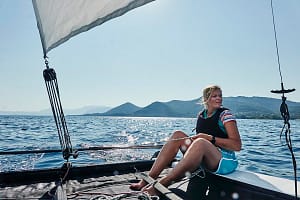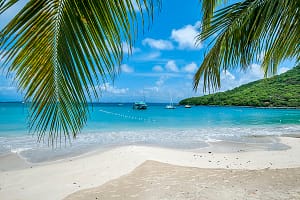Jean-François de Clermont-Tonnerre from AUM Asset Management discusses the role marine biodiversity and the earth’s oceans play in our survival as a species…
The oceans are our life force. As well as housing around 10 million marine species, microbes and bacteria that we need to balance the ecosystem, the world’s seas are a major cornerstone of the global economy.
Our oceans are an essential source of all kinds of resources for the unstoppably increasing population. They give us food, jobs and livelihoods to more than three billion people. They provide a home for the 2.4 billion people who live around the world’s coasts. And they are the facilitator of trade and commerce.
Given just how critical the oceans are to humanity, it’s surprising and disturbing to find that investment into marine biodiversity and the ocean economy is low. Over the past ten years, only 1% of the ocean economy’s total value was invested into sustainable projects.
Our current trajectory demands a sustainable ocean economy
Climate change, excessive pollution and the dangers of overfishing are all conspiring to put immense pressure on the oceans. This is threatening not only the marine biodiversity within, but the services it provides to humanity. If we truly want to change the trajectory we’re on then it’s time for us to put our money where our mouths are.
Capital from every source, including philanthropic, funds and public, must go towards ensuring the ocean has the resilience and infrastructure to survive the risks facing it. This means managing the way we use the delicate ecosystems and restoring and protecting them.
This means a total rethink and a baseline change of attitude, understanding and education on the way humans interact with the oceans. We must now make this critical move towards slowing the fall in ocean and marine biodiversity.
Transforming market systems and economic models is fundamental in making these changes a reality. Our priority must now be to halt biodiversity loss in its tracks and understand, respect and work with the potential in the oceans. What we need is a sustainable ocean economy (SOE).
What are the current threats to marine biodiversity?
We all know that without sustainable oceans, we cannot rely on a future for the human race. Seas cover more than 70% of the earth’s surface. If we continue as we are, with no changes, then according to UNESCO more than half of the marine species on earth will be extinct.
Currently almost two-third of the marine ecosystems that we rely on for food, livelihoods and life, are being used unsustainably. They are being degraded and destroyed.
To mitigate this, World Heritage Marine Protected Areas (MPAs) exist. These essential protected areas are there to conserve marine biodiversity and to maintain fish stocks. If we compare ecological drives to protect land and wooded areas, the oceans are far less shored up by investment. Around 12% of endangered land areas is under protection, but just 1% of the oceans.
Here are some more statistics from UNESCO that illustrate exactly how close we are to destroying the marine biodiversity and delicate ocean ecosystem that we need to survive:
- Half of the earth’s oxygen is provided by tiny phytoplankton living in the oceans. These are the base of the food chain that goes up through fish to marine mammals and finally to humans.
- Ocean acidification threatens this plankton, which could feasibly kill off larger fish.
- Levels of atmospheric CO2 are rising constantly, and if this continues as it is now, the ocean will no longer sustain marine organisms with shells. We just don’t know whether they can or will adapt.
- Ocean acidification will also make most of the ocean uninhabitable to coral reefs. This will have a devastating impact on everything from protecting the shoreline to food security and marine biodiversity.
- Overfishing is causing global fisheries to simply collapse.
- All kinds of human practices, from agriculture to heavy tourism, harbour and urban developments and many others are all sources of marine pollution.
- Marine ecosystems are collapsing due to the excess in nutrients poured into them from sewage outfalls and agricultural runoff. These ‘dead zones’ now cover an area of ocean equivalent in size to the UK.
- We’ve already destroyed around a third of critical marine habitats such as coral reefs, mangroves and seagrasses.
More private, public and philanthropic investment is necessary
The evidence is now overwhelming that there must be much more investment towards an SOE. There is, right now, a major gap in finance for the support of a sustainable ocean economy.
Research by the High Level Panel for an SOE shows that an investment of $1 into key actions to restore and protect marine biodiversity will yield a minimum of $5 in global benefits. Investments that target ocean improvement can also be part of the economic recovery from COVID-19. As they offer yields and economic benefits, the contribution towards a sustainable ocean economy offers all kinds of non-material value too.
In the simplest terms, if we don’t transition the way we invest in our oceans, then there will be an enormously high cost to pay. Unrestricted climate change could feasibly lead to a devastating fall in long-term tourism and fish stocks. This will cause catastrophic problems, particularly for developing countries that rely on both of these sectors not only for food security, but also jobs and infrastructure.
Despite all of these very sound and easily ascertained reasons to create an SOE, there is a massive financial deficit in the ongoing struggle to protect marine biodiversity. The funding simply isn’t there in the quantities it needs to be. A report by the Paulson Institute estimates that funding for biodiversity is dealing with an annual shortfall of between $598 and $824 billion on average.
These are only estimated, but there is no doubt that to truly protect marine biodiversity and stem the potentially devastating impact of uncontrolled climate change, regular investment must flow towards the creation of a sustainable SOE.
Closing the gap in funding and education
There appear to be fundamental gaps in education and understanding regarding just how the OE contributes to the wider global economy. Readily accessible information about the economic, environmental and social impact of the ocean is scarce or missing in many cases.
Many of the services that the ocean economy provides are also not adequately and openly reflected in market prices. This often leaves investors out of the picture when it comes to the potential value of their investments. So, to increase financing there must be much more effective communication and clear transparent measuring of the contribution it would be make.
There are also few comprehensive, universal regulations, standards and definitions on what comprises an SOE investment. This lack of uniformity and clarity is damaging. To combat this, the development of the Sustainable Blue Economy Finance Principle in 2018 gives us hope that this will begin to guide both public and private sector financing of the ocean economy. This Principle forms part of the United Nations Environment Programme and aligns with Sustainable Development Goal 14.
The Sustainable Blue Economy Finance Initiative exists to help guide the role of investors, philanthropists, banks and insurers in financiang a SOE. The initiative was developed by the European Investment Bank, WWF, the World Resources Institute and the European Commission.
The oceans are the lungs of this planet. We must work towards supporting this economy. Thankfully, it is increasingly attracting investors. Now the focus must be on attracting more and making it go further, before it’s too late.






Leave a Comment